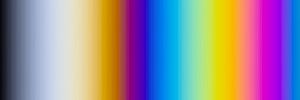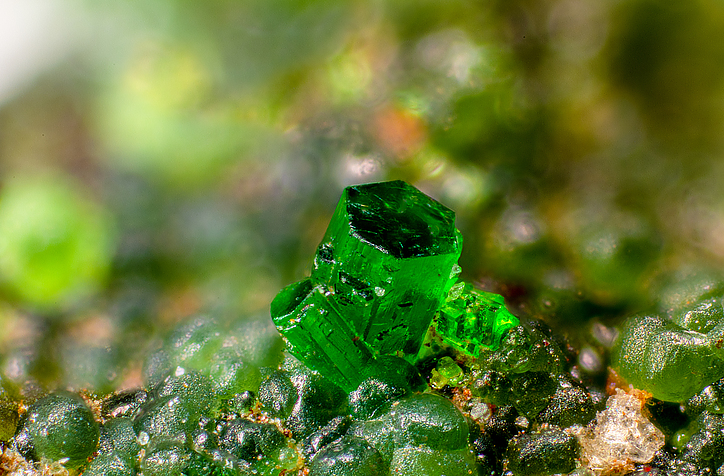Kambaldaite
A valid IMA mineral species
This page is currently not sponsored. Click here to sponsor this page.
About Kambaldaite

Kambalda Nickel mines underground, 1970.
Kambalda Nickel mines, Kambalda, Coolgardie Shire, Western Australia, Australia
Kambalda Nickel mines, Kambalda, Coolgardie Shire, Western Australia, Australia
Formula:
NaNi4(CO3)3(OH)3 · 3H2O
Colour:
Emerald-green, bright grass green
Lustre:
Vitreous, Silky
Hardness:
3
Specific Gravity:
3.18
Crystal System:
Hexagonal
Name:
Named after the type locality.
This page provides mineralogical data about Kambaldaite.
Unique Identifiers
Mindat ID:
2145
Long-form identifier:
mindat:1:1:2145:2
GUID
(UUID V4):
(UUID V4):
1f23d96d-5634-44f3-8f69-aa1f8d84f822
IMA Classification of Kambaldaite
Approved
First published:
1985
Classification of Kambaldaite
5.DA.20
5 : CARBONATES (NITRATES)
D : Carbonates with additional anions, with H2O
A : With medium-sized cations
5 : CARBONATES (NITRATES)
D : Carbonates with additional anions, with H2O
A : With medium-sized cations
16b.7.12.1
16b : HYDRATED CARBONATES CONTAINING HYDROXYL OR HALOGEN
7 : Miscellaneous
16b : HYDRATED CARBONATES CONTAINING HYDROXYL OR HALOGEN
7 : Miscellaneous
11.14.7
11 : Carbonates
14 : Carbonates of Co and Ni
11 : Carbonates
14 : Carbonates of Co and Ni
Mineral Symbols
As of 2021 there are now IMA–CNMNC approved mineral symbols (abbreviations) for each mineral species, useful for tables and diagrams.
| Symbol | Source | Reference |
|---|---|---|
| Kbd | IMA–CNMNC | Warr, L.N. (2021). IMA–CNMNC approved mineral symbols. Mineralogical Magazine, 85(3), 291-320. doi:10.1180/mgm.2021.43 |
Physical Properties of Kambaldaite
Vitreous, Silky
Transparency:
Transparent, Translucent
Colour:
Emerald-green, bright grass green
Streak:
Pale green
Hardness:
3 on Mohs scale
Cleavage:
None Observed
Density:
3.18 g/cm3 (Measured) 3.193 g/cm3 (Calculated)
Optical Data of Kambaldaite
Type:
Uniaxial (+)
RI values:
nω = 1.650 nε = 1.690
Max Birefringence:
δ = 0.040

Image shows birefringence interference colour range (at 30µm thickness)
and does not take into account mineral colouration.
and does not take into account mineral colouration.
Surface Relief:
High
Pleochroism:
Strong
Comments:
E : emerald green, and O : light green.
Chemistry of Kambaldaite
Mindat Formula:
NaNi4(CO3)3(OH)3 · 3H2O
Crystallography of Kambaldaite
Crystal System:
Hexagonal
Class (H-M):
6 - Pyramidal
Space Group:
P63
Cell Parameters:
a = 10.340(3) Å, c = 6.097(2) Å
Ratio:
a:c = 1 : 0.59
Unit Cell V:
564.6 ų
Z:
2
Morphology:
Hexagonal prisms, generally terminated by basal pinacoids. Some crystals are terminated by second-order pyramids, together with small pinacoidal faces.
Crystal Structure
Load
Unit Cell | Unit Cell Packed
2x2x2 | 3x3x3 | 4x4x4
Unit Cell | Unit Cell Packed
2x2x2 | 3x3x3 | 4x4x4
Show
Big Balls | Small Balls | Just Balls | Spacefill
Polyhedra Off | Si Polyhedra | All Polyhedra
Remove metal-metal sticks
Big Balls | Small Balls | Just Balls | Spacefill
Polyhedra Off | Si Polyhedra | All Polyhedra
Remove metal-metal sticks
Display Options
Black Background | White Background
Perspective On | Perspective Off
2D | Stereo | Red-Blue | Red-Cyan
Black Background | White Background
Perspective On | Perspective Off
2D | Stereo | Red-Blue | Red-Cyan
View
CIF File Best | x | y | z | a | b | c
CIF File Best | x | y | z | a | b | c
Rotation
Stop | Start
Stop | Start
Labels
Console Off | On | Grey | Yellow
Console Off | On | Grey | Yellow
Data courtesy of the American Mineralogist Crystal Structure Database. Click on an AMCSD ID to view structure
| ID | Species | Reference | Link | Year | Locality | Pressure (GPa) | Temp (K) |
|---|---|---|---|---|---|---|---|
| 0000983 | Kambaldaite | Engelhardt L M, Hall S R, White A H (1985) Crystal Structure of kambaldaite, Na2Ni8(CO3)6(OH)6(H2O)6 American Mineralogist 70 423-427 |  | 1985 | 0 | 293 |
CIF Raw Data - click here to close
X-Ray Powder Diffraction
Powder Diffraction Data:
| d-spacing | Intensity |
|---|---|
| 9.03 Å | (100) |
| 4.490 Å | (90) |
| 3.613 Å | (40) |
| 2.681 Å | (40) |
| 2.584 Å | (40) |
| 2.519 Å | (40) |
| 2.263 Å | (40) |
Geological Environment
Paragenetic Mode(s):
| Paragenetic Mode | Earliest Age (Ga) |
|---|---|
| Stage 7: Great Oxidation Event | <2.4 |
| 47a : [Near-surface hydration of prior minerals] | |
| 47c : [Carbonates, phosphates, borates, nitrates] |
Type Occurrence of Kambaldaite
General Appearance of Type Material:
Cryptocrystalline veins, layers and concretionary growths up to about 2 mm thick, commonly intergrown with gaspeite. Also as encrustations of tiny hexagonal prisms.
Place of Conservation of Type Material:
Division of Mineralogy, CSIRO, Perth, Western Australia, Australia, numbers M62.1991 , MDC 6595.
Government Chemical Laboratories of Western Australia, Australia.
The Australian Museum, Sydney, Australia, number D48054.
British Museum of Natural History, London, UK, number BM 1985,497.
Smithsonian Institution in Washington, D.C., USA.
Museum of Victoria, Melbourne, Australia, number M37494.
Government Chemical Laboratories of Western Australia, Australia.
The Australian Museum, Sydney, Australia, number D48054.
British Museum of Natural History, London, UK, number BM 1985,497.
Smithsonian Institution in Washington, D.C., USA.
Museum of Victoria, Melbourne, Australia, number M37494.
Geological Setting of Type Material:
Nickel sulfide deposit. A secondary mineral that has been precipitated on fracture surfaces in oxidizing Ni-Fe sulfide ore.
Associated Minerals at Type Locality:
Reference:
Nickel, E.H., Robinson, B.W. (1985) Kambaldaite - a new hydrated Ni-Na carbonate mineral from Kambalda, Western Australia. American Mineralogist: 70: 419-422.
Synonyms of Kambaldaite
Other Language Names for Kambaldaite
Common Associates
Associated Minerals Based on Photo Data:
Related Minerals - Strunz-mindat Grouping
| 5.DA. | Alexkhomyakovite | K6(Ca2Na)(CO3)5Cl · 6H2O |
| 5.DA. | Amoraite | Ca12Al6(OH)36(CO3)2(SO3) · 15H2O |
| 5.DA.05 | Dypingite | Mg5(CO3)4(OH)2 · 5H2O |
| 5.DA.05 | Giorgiosite | Mg5(CO3)4(OH)2 · 5-6H2O |
| 5.DA.05 | Hydromagnesite | Mg5(CO3)4(OH)2 · 4H2O |
| 5.DA.05 | Widgiemoolthalite | Ni5(CO3)4(OH)2 · 5H2O |
| 5.DA.05 | UM1986-10-CO:ClHMgMnZn (also called Mineral F, Dunn, 1995) | Mg5(Zn,Mn)3(CO3)2(OH,Cl)12 · H2O |
| 5.DA.05 | UM1987-01-CO:HMgS | Mg4(CO3)2(OH)4 · 6H2O ? |
| 5.DA.10 | Artinite | Mg2(CO3)(OH)2 · 3H2O |
| 5.DA.10 | Indigirite | Mg2Al2(CO3)4(OH)2 · 15H2O |
| 5.DA.10 | Chlorartinite | Mg2(CO3)(OH)Cl · 2H2O |
| 5.DA.15 | Otwayite | Ni2(CO3)(OH)2 · H2O |
| 5.DA.15 | Zaratite | Ni3(CO3)(OH)4 · 4H2O ? |
| 5.DA.25 | Callaghanite | Cu2Mg2(CO3)(OH)6 · 2H2O |
| 5.DA.30 | Claraite | (Cu,Zn)15(CO3)4(AsO4)2(SO4)(OH)14 · 7H2O |
| 5.DA.35 | Hydroscarbroite | Al14(CO3)3(OH)36 · nH2O |
| 5.DA.35 | Scarbroite | Al5(CO3)(OH)13 · 5H2O |
| 5.DA.40 | Caresite | Fe2+4Al2(OH)12[CO3] · 3H2O |
| 5.DA.40 | Quintinite | Mg4Al2(OH)12(CO3) · 3H2O |
| 5.DA.40 | Charmarite | Mn2+4Al2(OH)12[CO3] · 3H2O |
| 5.DA.40 | Karchevskyite | Mg18Al9(OH)54Sr2(CO3)9(H2O)6 (H3O)5 |
| 5.DA.40 | UM1987-05-OH:AlCMg | Mg4Al2(OH)12(CO3,SO4) · 3H2O |
| 5.DA.45 | Stichtite-2H | Mg6(Cr,Al)2(CO3)(OH)16 · 4H2O |
| 5.DA.45 | Brugnatellite | Mg6Fe3+(CO3)(OH)13 · 4H2O |
| 5.DA.45 | Chlormagaluminite | Mg4Al2(OH)12Cl2 · 3H2O |
| 5.DA.45 | Hydrotalcite-2H | Mg6Al2(CO3)(OH)16 · 4H2O |
| 5.DA.45 | Pyroaurite-2H | Mg6Fe3+2(OH)16(CO3) · 4H2O |
| 5.DA.45 | Zaccagnaite | Zn4Al2(OH)12[CO3] · 3H2O |
| 5.DA.45 | Liudongshengite | Zn4Cr2(OH)12(CO3) · 3H2O |
| 5.DA.50 | Comblainite | Ni4Co2(OH)12[CO3] · 3H2O |
| 5.DA.50 | Desautelsite | Mg6Mn3+2(OH)16[CO3] · 4H2O |
| 5.DA.50 | Hydrotalcite | Mg6Al2(CO3)(OH)16 · 4H2O |
| 5.DA.50 | Pyroaurite | Mg6Fe3+2(OH)16[CO3] · 4H2O |
| 5.DA.50 | Reevesite | Ni6Fe3+2(OH)16(CO3) · 4H2O |
| 5.DA.50 | Stichtite | Mg6Cr3+2(OH)16[CO3] · 4H2O |
| 5.DA.50 | Takovite | Ni6Al2(OH)16[CO3] · 4H2O |
| 5.DA.50 | Kaznakhtite | Ni6Co3+2(CO3)(OH)16 · 4H2O |
| 5.DA.55 | Coalingite | Mg10Fe3+2(OH)24[CO3] · 2H2O |
| 5.DA.55 | Akopovaite | Al4Li2(OH)12(CO3)(H2O)3 |
| 5.DA.60 | Šlikite | Zn2Mg(CO3)2(OH)2 · 4H2O |
| 5.DA.65 | Marklite | Cu5(CO3)2(OH)6 · 6H2O |
Other Information
Notes:
Not readily soluble in cold 1:1 HCl or l:1 HNO3.
Health Risks:
No information on health risks for this material has been entered into the database. You should always treat mineral specimens with care.
Internet Links for Kambaldaite
mindat.org URL:
https://www.mindat.org/min-2145.html
Please feel free to link to this page.
Please feel free to link to this page.
Search Engines:
External Links:
Mineral Dealers:
References for Kambaldaite
Reference List:
Nickel, Ernest H., Robinson, Bruce W. (1985) Kambaldaite-a new hydrated Ni-Na carbonate mineral from Kambalda, Western Australia. American Mineralogist, 70 (3-4) 419-422
Engelhardt, Lutz M., Hall, Sydney R., White, Allan H. (1985) Crystal structure of kambaldaite, Na2Ni8(CO3)6(OH)6·6H2O. American Mineralogist, 70 (3-4) 423-427
Localities for Kambaldaite
Locality List
 - This locality has map coordinates listed.
- This locality has map coordinates listed.
 - This locality has estimated coordinates.
ⓘ - Click for references and further information on this occurrence.
? - Indicates mineral may be doubtful at this locality.
- This locality has estimated coordinates.
ⓘ - Click for references and further information on this occurrence.
? - Indicates mineral may be doubtful at this locality.
 - Good crystals or important locality for species.
- Good crystals or important locality for species.
 - World class for species or very significant.
(TL) - Type Locality for a valid mineral species.
(FRL) - First Recorded Locality for everything else (eg varieties).
- World class for species or very significant.
(TL) - Type Locality for a valid mineral species.
(FRL) - First Recorded Locality for everything else (eg varieties).
All localities listed without proper references should be considered as questionable.
Australia | |
| Witzke (2023) |
| Nickel et al. (1985) |
| Nickel et al. (1993) +1 other reference |
Austria | |
| 58. +1 other reference |
Brazil | |
|
Quick NavTopAbout KambaldaiteUnique IdentifiersIMA Classification Classification Mineral SymbolsPhysical Properties Optical Data Chemistry Crystallography Crystal StructureX-Ray Powder DiffractionGeological EnvironmentType Occurrence SynonymsOther LanguagesCommon AssociatesStrunz-MindatOther InformationInternet Links References Localities Locality List





 symbol to view information about a locality.
The
symbol to view information about a locality.
The 



132 North Ni Mine, Widgiemooltha, Coolgardie Shire, Western Australia, Australia